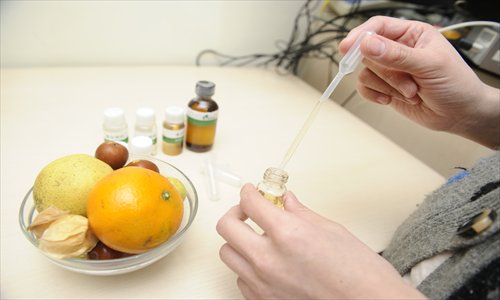Fretting about food
Anxious consumers snap up safety testing kits

A consumer tests fruit for harmful contaminants. Photo: Li Hao/GT
After a string of food safety scandals in recent years, some Chinese consumers are taking to products which allow users to test what they are eating for harmful contaminants.
The most common of these products are food safety testing strips, which can detect the presence of harmful toxins, pathogens and contaminants in food. Although experts warn that the results of such strips are not guaranteed to be accurate, hundreds of buyers have been snapping them up on China's online retail platforms.
"My sister-in-law had just given birth, so we were paying extra care to food safety," said a 27-year-old Anhui Province woman surnamed Qin, who bought four different kinds of food safety testing strips on Taobao. "One of them tests whether melamine is present in milk, and another tests whether there are any artificial contaminants in red wine."
The food safety testing strips work much like pregnancy test strips. The strip is applied to the food to be tested, and depending on whether it changes color, one can detect whether harmful components are present.
"Over the past year, food safety testing kits have been used by more and more people," said Sang Lichuan, general manager of Zhiyunda Technology Limited Corporation, a company that produces the kits. "Given that third-party testing and laboratory testing is inaccessible to most people due to prohibitively high costs, customers are turning to these methods."
The other two kits that Qin bought were to test for the presence of hydrogen peroxide in pork, and pesticide residues in vegetables.
According to the testing strips, the milk and the red wine were free of the contaminants being tested for, but some vegetables she had bought from a local market contained excessive amounts of pesticide residue.
"An [online] customer service representative [for the food safety testing kit] advised me to wash the contaminated vegetables with baking soda," said Qin. "I feel a lot more secure about what I'm eating."
Food safety testing kits are widely available online in China. Qin said that in total, all four kits she bought came to less than 200 yuan ($32).
Sang said that most of the consumers for their products were from first-tier and second-tier cities. In addition to the testing strips they currently produce, he said that they were developing new products that would be able to detect whether foods had been genetically modified or not.
Besides the rather elementary food safety testing strips, other companies have launched products that make use of electronic technology to detect for the presence of toxins and other harmful contaminant in food.
Among them are "Baidu Chopsticks," which is able to test for the use of gutter oil, and "Greentest," a needle-like device which tests for contaminants in fruit and vegetables. Both devices require the user to plunge the device into the food item to be tested.
Although the food safety testing products on the market allow consumers to take the initiative in protecting themselves from contaminated foods, Zhu Yi, an associate professor at the China Agricultural University, said that people should be wary about trusting the results.
"Food safety testing strips are efficient and effective, but their accuracy rate is, on average, only 70 percent," she said. Zhu said that perhaps a better precaution for consumers to adopt was to pay attention to where their food was coming from.
"It's more important to choose carefully what food you buy, and where you buy it from," he said. "It is better to buy food from large supermarkets, vegetable markets, or to choose products that have a good reputation."
Newspaper headline: Anxious consumers snap up safety testing kits